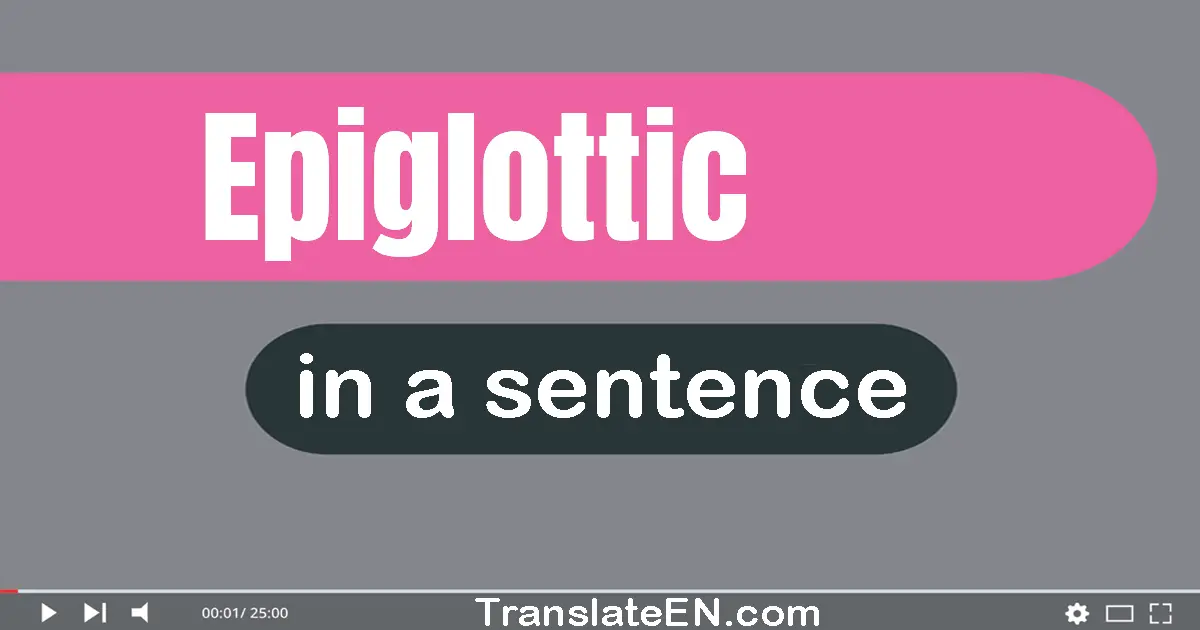Epiglottic in a sentence

(1) The epiglottic shape resembles a leaf.
(2) The epiglottic closure is an automatic reflex.
(3) The epiglottic muscles relax after swallowing.
(4) The epiglottic muscles play a role in phonation.
(5) The epiglottic closure is a protective mechanism.
(6) The epiglottic reflex is an involuntary response.
(7) The epiglottic position changes during swallowing.
(8) The epiglottic cartilage is made of elastic tissue.
(9) The epiglottic flap is covered with mucous membrane.
(10) The vallecula is also known as the epiglottic fossa.
Epiglottic sentence
(11) The epiglottic movement is controlled by the brainstem.
(12) The epiglottic shape varies slightly among individuals.
(13) The epiglottic cartilage is important for vocalization.
(14) The epiglottic muscles contract to close off the airway.
(15) The epiglottic cartilage is flexible and can move freely.
(16) The epiglottic position changes during speech production.
(17) The epiglottic position can be visualized during endoscopy.
(18) The epiglottic flap closes off the larynx during swallowing.
(19) The epiglottic shape helps guide food towards the esophagus.
(20) The epiglottic flap seals off the trachea during swallowing.
Epiglottic make sentence
(21) The epiglottic movement is crucial for protecting the airway.
(22) The epiglottic muscles control the movement of the epiglottis.
(23) The epiglottic cartilage is located at the base of the tongue.
(24) The epiglottic closure is essential for preventing aspiration.
(25) The epiglottic reflex protects the airway from foreign objects.
(26) The epiglottic function is to direct food towards the esophagus.
(27) The epiglottic flap opens to allow air to pass through the larynx.
(28) The epiglottic cartilage helps prevent food from entering the trachea.
(29) The epiglottic movement is coordinated with the muscles of the tongue.
(30) The epiglottic movement is coordinated with the muscles of the pharynx.
Sentence of epiglottic
(31) The epiglottic reflex is triggered by the presence of food in the mouth.
(32) The epiglottic notch is a small indentation at the top of the epiglottis.
(33) The epiglottic swelling can occur due to infection, inflammation, or injury.
(34) The epiglottic fold is a ridge of tissue that runs along the top of the epiglottis.
(35) The epiglottic flap is controlled by the glossopharyngeal nerve and the vagus nerve.
(36) The epiglottic muscles help to control the movement of the epiglottis during swallowing.
(37) The epiglottic cyst is a rare condition that can cause difficulty swallowing and breathing.
(38) The epiglottic cartilage is a small, leaf-shaped structure located at the base of the tongue.
(39) The epiglottic diverticulum is a pouch that forms in the epiglottis due to a weakness in the tissue.
(40) The epiglottic flap closes off the trachea during swallowing to prevent food from entering the lungs.
(41) The epiglottic reflex is a protective mechanism that prevents food and liquid from entering the airway.
Epiglottic meaning
Epiglottic is an adjective that describes something related to the epiglottis, which is a flap of cartilage located at the base of the tongue that prevents food and liquid from entering the trachea during swallowing. The word epiglottic is commonly used in medical contexts, but it can also be used in everyday language to describe things that are related to the epiglottis. Here are some tips for how to use the word epiglottic in a sentence:
1. Use it in a medical context: The epiglottic cartilage is an important structure in the respiratory system.
2. Use it to describe a symptom: The patient complained of epiglottic pain and difficulty swallowing.
3. Use it to describe a physical characteristic: The epiglottic flap was clearly visible during the endoscopic examination.
4. Use it to describe a function: The epiglottic reflex prevents food from entering the airway during swallowing.
5. Use it to compare and contrast: The epiglottic cartilage is larger in humans than in other primates.
6. Use it to explain a condition: Epiglottitis is a rare but serious infection of the epiglottic cartilage.
7. Use it to describe a treatment: The patient underwent epiglottic surgery to remove a tumor.
8. Use it to emphasize a point: The epiglottic reflex is a crucial protective mechanism that prevents aspiration.
9. Use it to describe a research finding: The study found that the epiglottic angle was significantly correlated with the severity of obstructive sleep apnea.
10. Use it creatively: The epiglottic dance is a unique form of movement that involves manipulating the epiglottis to produce unusual sounds.
In conclusion, the word epiglottic is a useful term that can be used in a variety of contexts to describe things related to the epiglottis. By following these tips, you can use the word effectively and accurately in your writing and speech.
The word usage examples above have been gathered from various sources to reflect current and historical usage of the word Epiglottic. They do not represent the opinions of TranslateEN.com.
